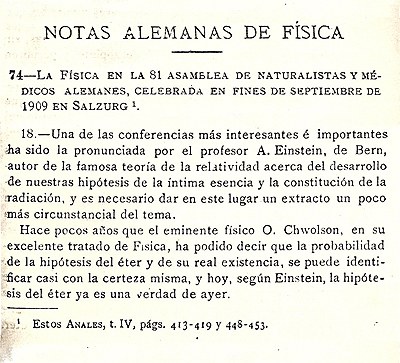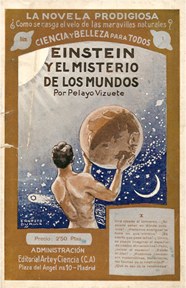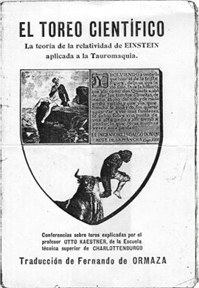Publications on Einstein and his work
Texts by Dr. Antonio Moreno González
An immense amount has been written about Einstein and his work, perhaps more than any other topic of scientific interest. The publications listed here are just a few of the many in Spanish dealing with Einstein's life. A search on Internet for the name "Albert Einstein" turns up 800,000 hits, as compared to 420,000 for his nearest rival, Winston Churchill. The next most quoted physicist is Niels Bohr, with just 80,000 hits.
The first news to spread to Spain about Einstein's famous 1905 articles in Annalen der Physik was published in Anales de la Sociedad Española de Física y Química . In Vol. 18 (1910), Note 74 of the "German Physics Notes" sent to the journal by the German professor Werner Mecklenburg, refers to "Physics at the 81st assembly of German Naturalists and physicians, held in September 1909 in Salzburg". Einstein, who had left his job in the patent office in Berne in July 1909 to occupy a position as an associate lecturer in Theoretical Physics at the University of Zurich, has spoken at the assembly; it was his first public appearance at a scientific meeting and people were interested to hear what he had to say.
The note in the Anales begins: "One of the most interesting and important lectures was given by Professor A. Einstein, from Berne, author of the famous theory of relativity, regarding the development of our hypotheses of the intimate essence and constitution of radiation [...]. According to Einstein, the hypothesis of the ether is now yesterday's truth". Much of the rest of the note, which continues in successive issues of the magazine is given over to treatises on "the nature of light". Interestingly, at that conference, Einstein argued that light might be considered to be both a wave and a particle (or "corpuscle"), "although--writes Mecklenburg--a mathematical theory of radiation has yet to be established which reproduces at the same time the structure of wave motion and the other structure of the quanta". This is a clear forerunner of what over the years would become Bohr's principle of complementarity, which Einstein, however, never accepted with all its consequences.
In 1920, Anales , the most widely read journal among university and secondary school teachers during the first three decades of the twentieth century, published an article by the astronomer Pedro Carrasco on "the present state of the theory of relativity", having already written another entitled "The Theory of Relativity" in El Ateneo de Madrid in 1916. In the same issue of Anales José María Plans published his "Note on the shape of light rays in the field of a gravitational centre in accordance with Einstein's theory". The two articles dealt with Einstein's recent (1919) discussion of the deflection of light in the proximity of an intense gravity field. In 1922, Plans, one of the people who best understood the theories of relativity in Spain, translated (Calpe, Madrid) such fundamental works as Space, Time and Gravitation , by Arthur Eddington, and Erwin Freundlich's The Foundations of Einstein's Theory of Gravitation . In 1933, Eddington's The Expanding Universe was translated for Revista de Occidente.
The philosopher Manuel García Morente translated Space and Time in Contemporary Physics (1921) by Moritz Schlick and Einstein's Theory of Relativity (1922) by Max Born for Calpe. The latter was one of the books about his work that Einstein himself most admired.
Other translations published in Spain included: Einstein for Everyone (1922), by Georg N. Felke, Einstein and the Universe. A Popular Exposition of the Famous Theory , by Charles Nordmann Introduction to the Theory of Relativity (1923), by Rudolf Lämmel, Introduction to Relativity (1923), by Paul Langevin and Space and Time (1931) by Emile Borel. The latter deals with the geometrical view of the universe based on relativist theories, and followed other original books in Spanish on the same theme such as: Espacio, Relación y Posición [Space, Relationship and Position] (1924) by the Viscount of Güell and Espacio, Hiperespacio y Tiempo [Space, Hyperspace and Time] (1928) by Francisco Vera.
Of the originals in Spanish, the most important were written by José María Plans and Blas Cabrera. Their publications on Einstein's theories included Nociones fundamentales de mecánica relativista [Basic Notions of Relativist Mechanics] (Madrid, 1921) by Plans; Principio de relatividad. Sus fundamentos experimentales y filosóficos y su evolución histórica [Principle of Relativity. Its Experimental and Philosophical Bases and its Historical Development (Madrid, 1923), by Cabrera. Esteban Terradas, an acquaintance of Einstein's and one of the people who was most influential in bringing him to Spain, published some articles and papers on the subject, but with less intensity than Plans and Cabrera.
In addition to serious publications like these, written from a position of scientific rigour and a knowledge of Einstein's theories, there were many other less significant works written from philosophical, political and religious positions, supporting or opposing relativity. In reality, relativity, was the only one of Einstein's theories to draw the attention of the general public, among other reasons because it was the one that received most coverage in the press, and in scientific and educational journals and institutions. There were also alternative proposals to the theories of Einstein, notably those of the insistent anti-relativist Horacio Bentabol, author of Observaciones contradictorias a la teoría de la relatividad del profesor Alberto Einstein [Observations contradicting Professor Albert Einstein's Theory of Relativity] (Madrid, 1925), and other less aggressive ones such as La Cósmica. Nueva teoría de la relatividad formal e intrínseca, fundada en el origen espiritual de la materia o en el tiempo como factor cósmico por excelencia [The Cosmic. New theory of Formal and Intrinsic Relativity, founded on the spiritual source of matter or on time as the cosmic factor par excellence (Madrid, 1932), by Osvaldo García de la Concha and Teoría de la Relatividad de Einstein. Compilación y comentarios y Principios esenciales de Acrofísica (Física superior o ultramatemática) [Einstein's Theory of Relativity. Compilation and Commentary and Essential Principles of Acrophysics (Higher or Ultra-mathematical Physics) (Madrid, 1931), by Camilo Calleja García. There were others which appropriated the term "relativity" to fields far removed from science such as, for example, bullfighting. This was the case, for example, of El Toreo Científico . La teoría de la relatividad de EINSTEIN aplicada a la Tauromaquia [Scientific Bullfighting. Einstein's Theory of Relativity applied to Bullfighting], written by Otto Kaetsner, lecturer at Higher Technical School of Charlottenburg, which ran to various editions in Spanish from 1920 on. And this was not the only case of "Einsteinean bullfighting".
Of the biographies translated into Spanish, written during Einstein's lifetime, some of the most important included one by H. Gordon Garbedian, who had the inestimable help of Einstein himself in writing Einstein, Maker of Universes (Buenos Aires, 1940), Philip Franck, his successor at the University of Prague, entitled Einstein (Barcelona, 1949) and Einstein, a biography (Buenos Aires, 1955), written by Antonina Vallentin, a friend of the Einstein family since their Berlin days

Anales de la Real Sociedad Española de Física y Química, year VIII, 1910, book VIII, p.286



